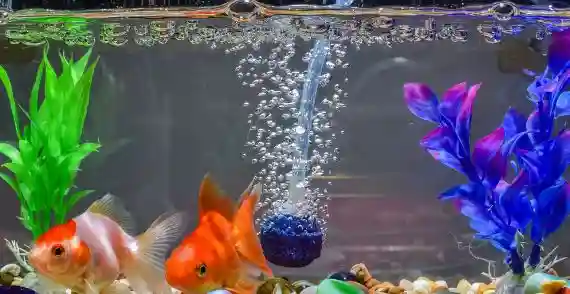Fish need oxygen to live. Oxygen is a gas that is mixed with water. Sometimes, there is too much oxygen in the water. This can hurt the fish and make them sick. In this article, we will tell you why this happens, how to check it, and how to fix it. One often overlooked aspect is the level of dissolved oxygen in the water. In this comprehensive guide, we delve into the signs, causes, and potential hazards of excessive oxygen in a fish tank. Our goal is to give you the information you need to make sure your underwater home for fish is balanced and better than other sources out there.
Understanding Excessive Oxygen in a Fish Tank
Oxygen, the life-giving element, plays a vital role in sustaining aquatic life. Fish and other underwater inhabitants rely on dissolved oxygen to breathe and thrive. However, just like any other element, an excess of oxygen can lead to unforeseen complications.
Signs of Excessive Oxygen in a Fish Tank

The first thing to do in order to keep the water balanced for your fish is to notice when there’s too much oxygen. Vigilance is key, as seemingly subtle cues can reveal underlying issues. Keep a watchful eye on your aquatic companions for these telltale indicators:
- Gasping at the Water Surface: While oxygen is essential, an excess can lead to fish gasping for air at the water’s surface. This behavior, known as “piping,” indicates a potential problem.
- Hyperactivity and Agitation: Fish experiencing oxygen stress may exhibit hyperactive behavior. It also shows darting around the tank erratically. Such agitation can stress the fish and disrupt their overall well-being.
- Bubble Nest Abandonment: Betta fish are famous for carefully building bubble nests, especially when they want to breed. Excessive oxygen can lead to the abandonment of these nests, signaling distress.
The Culprits Behind High Oxygen Levels in a Fish Tank
To address the issue, we must understand its root causes. Excessive oxygen levels can often be attributed to a combination of factors, including:
- Too Much Aeration: While adding air is important, if the air pump is too strong or you use too many air stones, it can make the water have too much oxygen.
- Lack of Plant Life: Aquatic plants play a vital role in maintaining oxygen balance through photosynthesis. In the absence of sufficient plant life, oxygen levels can surge.
- Improper Water Agitation: Water agitation, when excessive, can lead to increased oxygen exposure at the surface. This is often seen in tanks with aggressive filtration systems.
The Silent Dangers of Oxygen Overdose
Excessive oxygen, often mistaken for a boon, can gradually transform into a bane for your aquatic haven. Understanding the potential hazards is essential for preventing long-term damage.

- Oxygen Bubble Disease (GBD): This is a condition that not many people know about, but it’s serious. It happens when there’s too much oxygen and bubbles start forming inside a fish’s body. These bubbles can block blood vessels, leading to tissue damage and even death.
- Altered pH Levels: Oxygen levels are intricately linked with pH balance. Excessive oxygen can drive down pH levels, creating an acidic environment that jeopardizes fish health.
- Slow Growth and Development: If fish are exposed to too much oxygen for a long time, it can mess up how they grow and stop them from developing properly.
Strategies for Mitigating Oxygen Overload
Maintaining a thriving fish tank involves a holistic approach that addresses various factors. To restore oxygen equilibrium, consider the following steps:
- Adjust Aeration: Fine-tune your aeration setup by opting for adjustable air pumps and moderating the use of air stones.
- Add Water Plants: Putting different water plants in the tank doesn’t just make it look nice; it also helps control oxygen levels.
- Check the filter: Keep an eye on how strong the filter is and change it if needed so the water doesn’t move around too much.
sequenceDiagram
participant Fish
participant Oxygen
participant Aquatic Plants
participant Air Pump
Fish->>+Oxygen: Gasping at surface
Fish->>-Oxygen: Hyperactivity & agitation
Fish->>Aquatic Plants: Abandoned bubble nest
Oxygen->>Fish: Oxygen bubble disease
Oxygen->>+Fish: Altered pH levels
Fish->>Oxygen: Stunted growth & development
Oxygen->>Air Pump: Adjust aeration
Aquatic Plants->>Fish: Release oxygen through photosynthesis
Air Pump->>Aquatic Plants: Control oxygen input
Air Pump->>+Fish: Regulate aeration
Air Pump->>-Fish: Balanced oxygen levels
sequenceDiagram
participant Fish
participant Oxygen
participant Aquatic Plants
participant Air Pump
Fish->>+Oxygen: Gasping at surface
Fish->>-Oxygen: Hyperactivity & agitation
Fish->>Aquatic Plants: Abandoned bubble nest
Oxygen->>Fish: Oxygen bubble disease
Oxygen->>+Fish: Altered pH levels
Fish->>Oxygen: Stunted growth & development
Oxygen->>Air Pump: Adjust aeration
Aquatic Plants->>Fish: Release oxygen through photosynthesis
Air Pump->>Aquatic Plants: Control oxygen input
Air Pump->>+Fish: Regulate aeration
Air Pump->>-Fish: Balanced oxygen levels
sequenceDiagram
participant Fish
participant Oxygen
participant Aquatic Plants
participant Air Pump
Fish->>+Oxygen: Gasping at surface
Fish->>-Oxygen: Hyperactivity & agitation
Fish->>Aquatic Plants: Abandoned bubble nest
Oxygen->>Fish: Oxygen bubble disease
Oxygen->>+Fish: Altered pH levels
Fish->>Oxygen: Stunted growth & development
Oxygen->>Air Pump: Adjust aeration
Aquatic Plants->>Fish: Release oxygen through photosynthesis
Air Pump->>Aquatic Plants: Control oxygen input
Air Pump->>+Fish: Regulate aeration
Air Pump->>-Fish: Balanced oxygen levels
Conclusion
Too much oxygen in the water can come from different things, like having too many fish, giving them too much food, or having the water too hot. It can make the fish get bubbles in their blood and organs. This is called gas bubble disease. To stop this, you need to watch the oxygen level in the water. You can use a tool or a kit to do this. You also need to keep the water clean and not too crowded or warm. So, make sure you understand oxygen in the water and enjoy making your fish tank special!
Frequently Asked Questions (FAQs)
Welcome to our comprehensive FAQs section. Here we address common queries regarding maintaining optimal oxygen levels in your fish tank. Dive into these insights to enhance your understanding of this important aspect of aquatic care.
Why is oxygen balance important in a fish tank?
Oxygen is vital for fish and other aquatic inhabitants to breathe and thrive. Maintaining the right balance ensures their well-being and prevents potential health issues caused by excess or insufficient oxygen.
How can I tell if there’s too much oxygen in my fish tank?
Look out for signs such as fish gasping at the water surface, hyperactive behavior, and abandonment of bubble nests. These indicators suggest a potential oxygen overabundance.
What causes excessive oxygen levels in a fish tank?
Excessive oxygen can result from overpowering aeration, a lack of aquatic plants to regulate oxygen, and aggressive water agitation from filtration systems.
Can aquatic plants help regulate oxygen levels?
Yes, aquatic plants release oxygen through photosynthesis, contributing to a natural oxygen balance in the tank.
How can I adjust aeration effectively?
Use adjustable air pumps and moderate the use of air stones to control the amount of oxygen being infused into the water.
Are there any risks to lowering oxygen levels too much?
Yes, insufficient oxygen can lead to fish stress, slow growth, and even fatalities. It’s essential to strike a balance.
How often should I monitor the oxygen levels in my fish tank?
Regular monitoring is important, especially when making changes to your tank setup. Consider using oxygen test kits to assess levels accurately.






